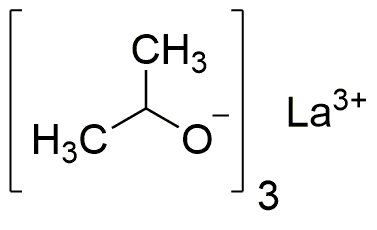Lanthanum(III) isopropoxide is widely utilized in research focused on:
- Catalysis: This compound serves as a catalyst in various organic reactions, enhancing reaction rates and selectivity, which is crucial in the production of fine chemicals.
- Materials Science: It is used in the synthesis of advanced materials, including ceramics and glass, where it improves thermal stability and mechanical properties.
- Nanotechnology: Lanthanum(III) isopropoxide plays a role in the fabrication of nanomaterials, particularly in creating nanoscale devices that are essential in electronics and photonics.
- Biomedical Applications: This compound is explored for its potential in drug delivery systems, where it can help in the controlled release of therapeutic agents.
- Environmental Remediation: It is investigated for its ability to remove heavy metals from wastewater, providing a sustainable solution for pollution control.
General Information
Properties
Safety and Regulations
Applications
Lanthanum(III) isopropoxide is widely utilized in research focused on:
- Catalysis: This compound serves as a catalyst in various organic reactions, enhancing reaction rates and selectivity, which is crucial in the production of fine chemicals.
- Materials Science: It is used in the synthesis of advanced materials, including ceramics and glass, where it improves thermal stability and mechanical properties.
- Nanotechnology: Lanthanum(III) isopropoxide plays a role in the fabrication of nanomaterials, particularly in creating nanoscale devices that are essential in electronics and photonics.
- Biomedical Applications: This compound is explored for its potential in drug delivery systems, where it can help in the controlled release of therapeutic agents.
- Environmental Remediation: It is investigated for its ability to remove heavy metals from wastewater, providing a sustainable solution for pollution control.
Documents
Safety Data Sheets (SDS)
The SDS provides comprehensive safety information on handling, storage, and disposal of the product.
Product Specification (PS)
The PS provides a comprehensive breakdown of the product’s properties, including chemical composition, physical state, purity, and storage requirements. It also details acceptable quality ranges and the product's intended applications.
Certificates of Analysis (COA)
Search for Certificates of Analysis (COA) by entering the products Lot Number. Lot and Batch Numbers can be found on a product’s label following the words ‘Lot’ or ‘Batch’.
*Catalog Number
*Lot Number
Certificates Of Origin (COO)
This COO confirms the country where the product was manufactured, and also details the materials and components used in it and whether it is derived from natural, synthetic, or other specific sources. This certificate may be required for customs, trade, and regulatory compliance.
*Catalog Number
*Lot Number
Safety Data Sheets (SDS)
The SDS provides comprehensive safety information on handling, storage, and disposal of the product.
DownloadProduct Specification (PS)
The PS provides a comprehensive breakdown of the product’s properties, including chemical composition, physical state, purity, and storage requirements. It also details acceptable quality ranges and the product's intended applications.
DownloadCertificates of Analysis (COA)
Search for Certificates of Analysis (COA) by entering the products Lot Number. Lot and Batch Numbers can be found on a product’s label following the words ‘Lot’ or ‘Batch’.
*Catalog Number
*Lot Number
Certificates Of Origin (COO)
This COO confirms the country where the product was manufactured, and also details the materials and components used in it and whether it is derived from natural, synthetic, or other specific sources. This certificate may be required for customs, trade, and regulatory compliance.


